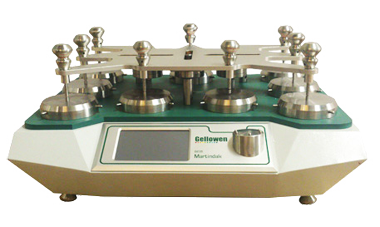
NewsInformation Center
How long should a Martindale abrasion test be humidified?
2023/11/15
Martindale wear testing is a common method used to evaluate the wear resistance of materials. When performing Martindale wear testing, it is important to control the test conditions, which include proper humidity. Below are answers to common questions you may have about humidity handling in Martindale abrasion testing.
1. Why do I need humidification?
In many cases, the wear characteristics of a material may be different under wet conditions than under dry conditions. Humidification simulates the use of the material in a wet environment and provides a more realistic assessment of wear properties.


2. Factors in determining humidification time:
Factors in determining humidification time include the following:
- Test standards: Depending on the test standard used, specific humidification time requirements may be available. Different standards may specify different humidification times.
- Material type: Different types of materials respond differently to humidity. Some materials may require longer humidification times to reach a steady state.
- Application environment: Considering the environmental conditions under which the material will be used in its actual application, the humidification time can be determined based on the desired humidity level and duration of use.
- Previous research or experience: Previous research or experience may provide a useful reference for determining humidification time.
3. Test methods for humidification time:
One of the common methods for determining humidification time is to conduct a pre-experiment. In a pre-experiment, a number of samples are subjected to desired humidity conditions and tested for wear at various points in time. By observing the changes in the wear characteristics, the required stabilization time of the material at a particular humidity condition can be determined.
4. Humidification methods:
Humidification methods can vary depending on laboratory conditions and requirements. The following are some common humidification methods:
- Room humidification: the sample is placed in a closed room with humidity control capabilities, and a humidity controller or humidification device is used to control the humidity level.
- Water vapor humidification: Humidity is increased by introducing steam or water vapor into the test environment. This can be accomplished using specialized humidification equipment or by placing water in the test chamber.
- Wet Cloth Humidification: Moist fabric or wet paper towels are placed near the sample to increase humidity by using water evaporation.
5. Practical examples of humidification times:
The exact humidification time depends on the properties of the material being tested and the level of humidity required. The following are some examples of practical cases:
- Textile abrasion testing: For Martindale abrasion testing of textiles, common humidification times can range from a few hours to 24 hours.
- Coated Material Abrasion Testing: For abrasion testing of coated materials, longer humidification times may be required, often in excess of 24 hours, to ensure that the material reaches a steady state of humidity.
Please note that the exact humidification time should be determined based on the test standard you are using, the type of material and specific requirements. It is recommended to refer to the relevant test standard or consult a professional for accurate humidification time recommendations.
To summarize, humidification time in Martindale wear testing depends on a number of factors, to learn more about it, send us a message.
Previous: Fbric Tear Testing: All your questions answered
N e x t : Test Methods and Finishing Methods of Fabric Pilling



